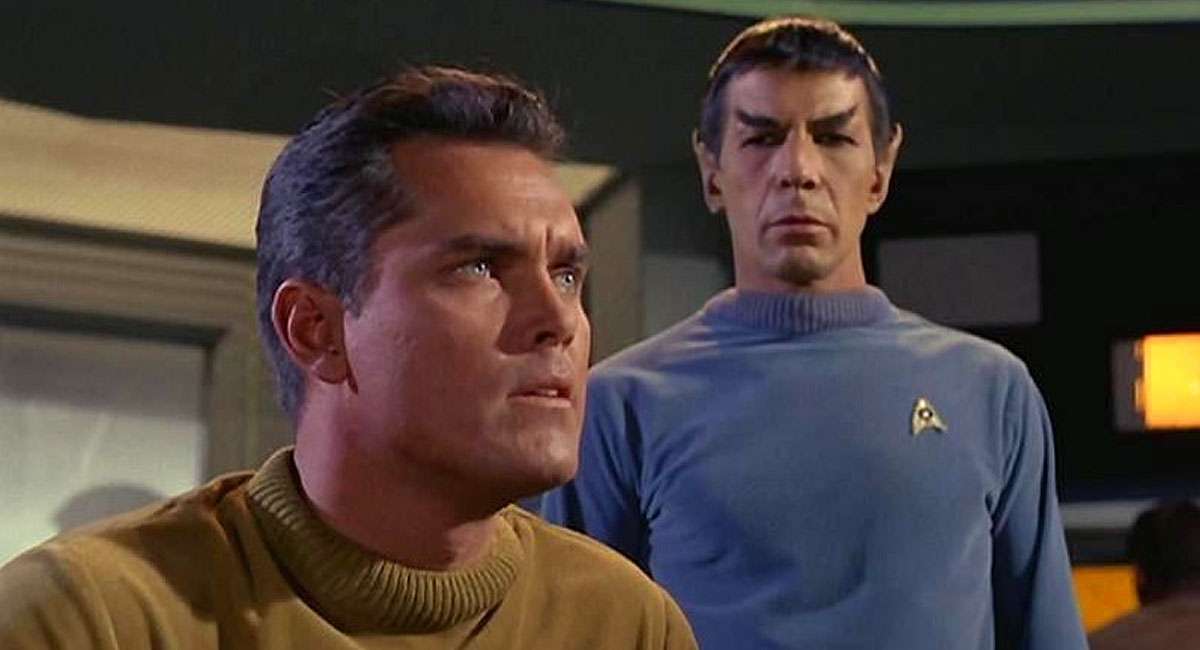
While Star Trek: Strange New Worlds brought the bellwether small screen space franchise back to its episodic procedural roots, the show also serves as the surreal, nearly 60-year culmination of a key character arc. Of course, said arc belongs to Captain Christopher Pike (Anson Mount), a character long relegated to the realm of trivia as James T. Kirk’s direct predecessor in the U.S.S. Enterprise captain’s chair. Indeed, Pike was the lead role in Star Trek’s 1966 network-rejected original pilot, in which he was played by famous film star Jeffrey Hunter. While the series would eventually make air on NBC with another pilot, the voyages would commence under the command of Kirk, not Pike, creating this current dynamic. Yet, the exact reason for this change is still mostly mired in anecdotal ambiguity.
Star Trek’s first pilot, informally titled in pre-production as “The Cage” (its eventual official name), as directed by Robert Butler and written by creator Gene Roddenberry, was the result of creative permutations (e.g. a captain character originally named Robert April), but the crux of Roddenberry’s pitch described a genre hybrid series that amalgamated the early-1960s dominance of Westerns with the emerging milieu of an outer space sci-fi setting. Thusly, the exploratory “wagon train to the stars” concept was complemented by a staple from the Western genre in would-be-series leading man Jeffrey Hunter. After all, he fielded several horseback-riding, gun-slinging showcases, and appeared opposite John Wayne in one of the most successful and beloved Western movies of all time, 1956’s The Searchers. However, much to network NBC’s chagrin, the Hunter-starring pilot leaned a little too far on the ponderously philosophical sci-fi side, sending things back to the drawing board.
The failure of “The Cage” to earn Star Trek a series order is a topic deep enough in its own right to warrant a separate story, but the setback did not lead to a proactive dismissal of Hunter. In fact, the show’s unlikely second lease on life with a mulligan pilot—thanks, in no small part, to the now-famous advocacy of producing Desilu studio head Lucille Ball—still initially involved having Hunter’s Captain Pike in the big bridge chair. However, mysterious variables had apparently changed by that time for Hunter, who ended up departing the contemporaneously inauspicious project. That is where things get rather hazy since there is now a permanent lack of a firsthand answer, seeing as Hunter died a few short years later in 1969 after sustaining a stroke and severe fall, leaving fans with differing accounts of the exit from producers and co-stars involved with the event. The only idea that seems consistent is that Hunter suddenly decided that he wanted nothing to do with Star Trek after the production of “The Cage” and NBC’s rejection.
One of the more detailed recollections of Hunter’s abrupt exit came from the 1999 book Inside Star Trek: The Real Story, which contains a collective account from Herbert F. Solow, head of Desilu Studios at the time, and Robert H. Justman, an assistant director, who, with Roddenberry (1921-1991), made up the show’s inaugural creative coalition. According to them, there was a substantial post-Cage plan to keep Hunter as the star, and the team attempted to retain the pilot star in the face of treatment that, in today’s parlance, would best be described as ghosting. That’s because the failure of “The Cage” created an escape loophole that Hunter would exploit, purportedly leading to a cut-off of direct communication with an out-reaching Roddenberry and company.
“We had an option on Jeff Hunter for a series, but not for another pilot film,” recalled Solow, via Star Trek Fact Check. “The idea of a network financing a second pilot film after the first one failed to result in a ‘sold’ series was unheard of, so there was no reason for such a contract provision. We therefore had to devise a plan that would enable us to keep Jeff Hunter in the fold.”
Allegedly, Hunter didn’t quite know what to make of Star Trek. He even seemed to share the network’s misgivings regarding how different the proposed Space Western idea was from what manifested in “The Cage.” The prototype pilot saw his Captain Pike held captive underground on the desolate, war-torn planet Talos IV by its bulb-headed inhabitants. There, the Talosians use their highly developed mental power to project an illusory romantic life for Pike and a young human female captive named Vina (Susan Oliver). Indeed, while concepts like the U.S.S. Enterprise, transporters, phasers and even Mr. Spock (Leonard Nimoy) were already there, and the plot would even prove typical for the franchise, one could have easily dismissed the show as an untenable, overly out-there endeavor. This made it an especially tough pill to swallow for Hunter at a point well past the splendor of his cinematic heights, which saw his stardom reduced to fielding cheap Western fodder. Star Trek, in that regard, had to feel like a new, ignominious pocket of humiliation residing below the regular depths of rock bottom.

“In the eyes of the New York and Los Angeles television world, Star Trek was already a failure,” continued Solow. “But we knew differently and looked forward to running the completed pilot for our star, Jeff Hunter. We hoped it would convince him to do another pilot.”
Additionally, recollections from not only Solow and Justman, but Leonard Nimoy and even William Shatner affirm the idea that Hunter’s wife, Joan Bartlett, heavily influenced his decision to cut ties with Star Trek. This presumably led to the aforementioned ghosting of the creative team during their attempts to procure him for the second pilot. Yet, the belief about Bartlett’s influence on her husband is mostly rooted in multiple accounts of one consequential moment in which she, not Hunter, showed up at Desilu Studios for a contemplative screening of “The Cage.” What allegedly followed was an absentee resignation from Star Trek by way of a spouse, in lieu of a face-to-face move.
“Gene and I waited in the Desilu projection room for him to arrive,” said Solow. “He never did. Arriving in his stead was actress [Joan] Bartlett, Mrs. Jeff Hunter. We traded hellos, and I nodded to Gene. He flicked the projection booth intercom switch. ‘Let’s go.’ And so it went. As the end credits rolled, and the lights came up, Jeff Hunter’s wife gave us our answer: ‘This is not the kind of show Jeff wants to do, and besides, it wouldn’t be good for his career. Jeff Hunter is a movie star.’ Mrs. Hunter was very polite and very firm. She said her good-byes and left, having surprisingly and swiftly removed our star from our new pilot.”
Consequently, in one fell (corporeally absent) swoop, the Star Trek role that would eventually become popularly connected to Jeffrey Hunter ended before it really began. The reason for the exit—notably exemplified by his unwillingness to even show up to deliver the news—might have centered on Hunter’s self-esteem as a diminished movie star, which might have been salvaged by the power move. Yet, a key witness in Hunter’s son, Christopher, believes that alcoholism significantly contributed to his father’s death. This could suggest a causal connection to the former A-lister’s late-life career troubles, including the odd abdication of his Pike role.
The seeds for Captain Pike’s legacy were nevertheless sown on Star Trek with Season 1’s November 1967 two-parter, “The Menagerie,” which utilized footage from the rejected pilot to canonize the heretofore unseen concept—since “The Cage” never aired in its full form until 1988—that Pike actually preceded Kirk as the Enterprise’s captain. It also established that Pike, after ceding command of the ship, was grievously wounded from a radiation leak while rescuing Starfleet cadets, permanently resigned to a hover chair, which also serves as his only means of communication, achieved through its blinking lights. While “The Menagerie” would serve as the Original Series’ last canonical story with Pike, decades later, Star Trek started revisiting him, first with the J.J. Abrams-directed 2009 reboot movie’s inclusion of the character, played by Bruce Greenwood as a gruff mentor to Chris Pine’s Kirk.
Of course, Pike would become fully embraced half a century after “The Cage” when the pre-Original-Series-set Star Trek: Discovery debuted Anson Mount’s version in 2019 for Season 2. Combining an earnest, aww-shucks enthusiasm with an alpha demeanor that Hunter could have embodied, Mount (and his version of the Enterprise crew, including Ethan Peck’s Spock) stole the spotlight, which quickly led to a Paramount+ green light for the Enterprise-set Strange New Worlds. After the overwhelming bleakness and arguable nihilism of Discovery and Star Trek: Picard, the new show has returned to an embrace of the franchise’s original optimistic exploration ethos for a new generation.

